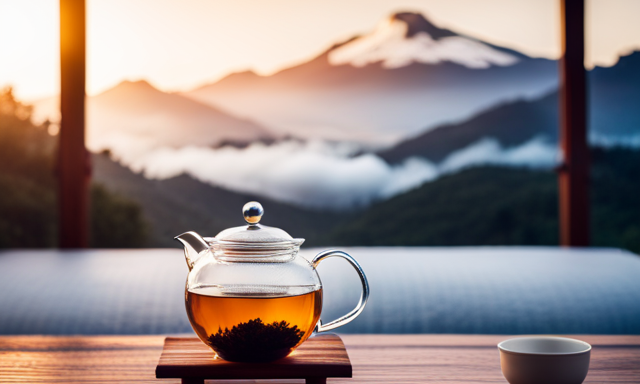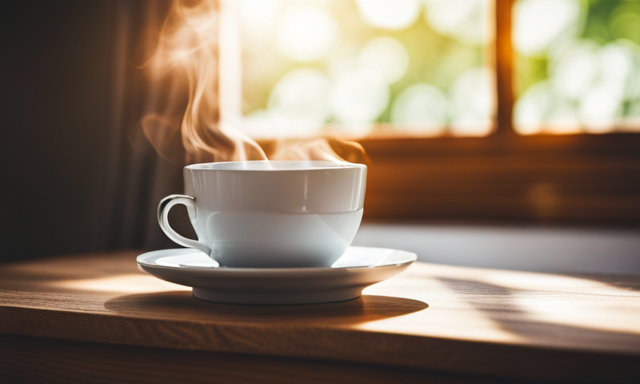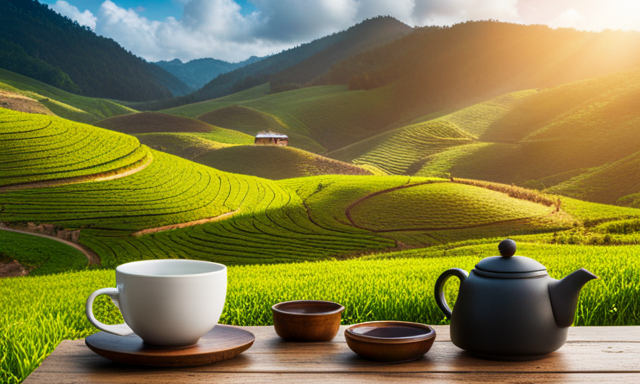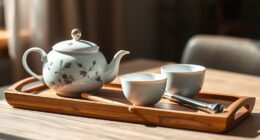Like a delicate dance between earth and fire, oolong tea captivates the senses with its unique flavors and aromas. As a tea enthusiast, I have come to appreciate the intricacies that make oolong tea different from other varieties.
In this article, we will explore the origins, processing methods, and distinct flavor profiles that set oolong tea apart. From its rich history and traditional brewing techniques to its health benefits and cultural significance, oolong tea has a story to tell. Join me on this journey as we delve into the world of oolong tea and uncover the secrets behind its exquisite taste.
With a wide range of varieties and grades to explore, we will discover how the terroir and tea leaves influence the final cup. So, sit back, relax, and let’s embark on an enlightening exploration of what makes oolong tea truly exceptional.
Key Takeaways
- Oolong tea is ideal for traditional tea ceremonies due to its unique flavor and delicate aroma.
- Different tea leaves and brewing techniques greatly impact the flavor and aroma of oolong tea.
- Oolong tea is a symbol of hospitality and respect in Chinese tradition and holds a significant place in Taiwanese culture.
- The unique flavors of oolong tea are influenced by the soil and climate it is grown in, resulting in distinct tasting notes.
Origin and History of Oolong Tea
The captivating story of how oolong tea originated and became a cherished part of my tea-drinking journey begins in China in the early 17th century. Legend has it that a tea farmer stumbled upon the unique processing method of oolong tea by accident. He was called away from his tea leaves and left them to wither in the sun. When he returned, the leaves had partially oxidized, resulting in a distinct flavor and aroma.
This discovery led to the development of oolong tea as we know it today. The processing of oolong tea involves withering, oxidizing, and then firing the leaves to stop the oxidation process. This unique processing method gives oolong tea its characteristic flavor and sets it apart from other teas.
Moving on to the subsequent section about the unique processing method, let’s delve deeper into the intricacies of oolong tea.
Unique Processing Method
The unique processing method of oolong tea sets it apart from other types of tea. Oolong tea production involves withering the leaves under the sun and then allowing them to oxidize partially before being rolled and twisted. This intricate process requires expert craftsmanship and attention to detail.
The level of oxidation can vary, resulting in a wide range of flavors and aromas. The unique flavor profile of oolong tea is a delicate balance between the freshness of green tea and the richness of black tea. It has a smooth, floral taste with hints of fruit and a sweet aftertaste.
This distinct flavor profile is what makes oolong tea so highly regarded by tea connoisseurs.
Distinct Flavor Profile
Crafted through an intricate process, oolong tea captivates with its unique flavor profile. It balances the freshness of green tea and the richness of black tea. Its flavor profile analysis reveals a complexity that sets it apart from other teas.
Oolong tea is known for its floral and fruity notes, with hints of honey and roasted undertones. The taste comparison to green tea showcases a more mellow and earthy flavor. On the other hand, the comparison to black tea highlights a smoother and less bitter taste.
This distinct flavor profile is a result of the partial oxidation process, which brings out the tea’s unique characteristics.
Moving forward to the discussion about the range of varieties and grades, it’s important to note that oolong tea offers an extensive selection that caters to different preferences and tastes.
Range of Varieties and Grades
With its wide array of varieties and grades, oolong tea offers a tantalizing journey for tea enthusiasts, igniting a sense of excitement and adventure. Oolong tea is known for its diverse range of flavors, which can vary depending on the variety and grade. From floral and fruity notes to earthy and toasty undertones, there is a flavor profile to suit every palate. The table below provides a glimpse into the different varieties and grades of oolong tea, showcasing their unique characteristics and brewing recommendations.
| Oolong Tea Grade | Flavor Profile | Brewing Recommendations |
|---|---|---|
| Tie Guan Yin | Floral, creamy | Steep at 195°F for 1-2 minutes |
| Da Hong Pao | Roasted, rich | Steep at 205°F for 3-4 minutes |
| Oriental Beauty | Honey, fruity | Steep at 185°F for 2-3 minutes |
| Ali Shan | Light, floral | Steep at 190°F for 2-3 minutes |
Understanding the different varieties and grades of oolong tea allows tea enthusiasts to explore and appreciate the nuances of this beloved beverage. As we delve deeper into the health benefits of oolong tea, we discover its remarkable impact on our well-being.
Health Benefits of Oolong Tea
Oolong tea offers several health benefits that make it a great addition to any diet.
First, it can aid in weight management by boosting metabolism and increasing fat oxidation.
Second, it promotes heart health by reducing cholesterol levels and improving blood pressure.
Lastly, oolong tea is rich in antioxidants, which help to combat free radicals and protect the body from oxidative stress.
Weight Management
Losing weight is a journey, but oolong tea can be a helpful companion along the way. When it comes to weight loss, oolong tea is known for its ability to boost metabolism. The polyphenols in oolong tea help increase fat oxidation and improve calorie burning. By drinking oolong tea regularly, you may notice a gradual reduction in body weight and fat mass.
Additionally, oolong tea can help regulate blood sugar levels, which can be beneficial for weight management. It also contains caffeine, which can provide an energy boost and enhance physical performance during exercise. So, if you’re looking to shed those extra pounds, consider incorporating oolong tea into your weight loss journey.
As we move on to the next section about heart health, let’s explore how oolong tea can benefit our cardiovascular well-being.
Heart Health
Oolong tea has been found to play a significant role in preventing heart disease. Studies have shown that regular consumption of oolong tea can help reduce cholesterol levels, which is a major risk factor for heart disease. The polyphenols present in oolong tea have been found to inhibit the absorption of dietary cholesterol, thus preventing its accumulation in the bloodstream. By lowering cholesterol levels, oolong tea promotes a healthier cardiovascular system and reduces the risk of heart-related ailments.
This makes it an excellent addition to a heart-healthy lifestyle. Moving forward, let’s explore how oolong tea’s antioxidant properties contribute to overall well-being.
Antioxidant Properties
Imagine the impact on your overall well-being when you discover the incredible antioxidant properties found in oolong tea. Antioxidants are compounds that help protect our cells from damage caused by harmful molecules called free radicals. Oolong tea contains a variety of antioxidants, including polyphenols and catechins, which have been shown to have numerous health benefits. These antioxidants can help reduce inflammation, lower the risk of chronic diseases such as heart disease and diabetes, and even aid in weight management.
To give you a better understanding of the antioxidant benefits of oolong tea, take a look at the table below:
| Antioxidant | Function | Benefits |
|---|---|---|
| Polyphenols | Reduce inflammation | Lower the risk of chronic diseases |
| Catechins | Aid in weight management | Boost metabolism |
To fully enjoy the antioxidant benefits of oolong tea, it is important to brew it properly. I recommend using water that is around 185°F (85°C) and steeping the tea leaves for 3-5 minutes. This will ensure that you extract the maximum antioxidants from the tea leaves.
Now, let’s delve into the fascinating world of tea ceremony and explore the connection between oolong tea and this ancient tradition.
Tea Ceremony and Oolong Tea
During a tea ceremony, oolong tea is prepared and served with great precision and attention to detail. The tea ceremony holds immense cultural significance, as it represents harmony, respect, and tranquility. It is a sacred ritual that has been practiced for centuries, showcasing the beauty and elegance of the tea culture.
Oolong tea, with its unique flavor profile and delicate aroma, is a perfect choice for such a ceremony. The tea leaves are carefully selected, and the brewing process requires expertise and skill. Each step of the preparation, from measuring the tea leaves to pouring the hot water, is executed with utmost care. The tea is then served in small cups, allowing the participants to savor its rich and complex taste.
Moving on to the next section about tea leaves and brewing techniques, let’s explore the various methods used to extract the best flavors from oolong tea.
Tea Leaves and Brewing Techniques
To enhance your oolong tea experience, explore the art of brewing with various tea leaves and masterful techniques. The type of tea leaves used and the brewing techniques employed greatly impact the flavor and aroma of oolong tea. Different leaves, whether tightly rolled or open, can produce a range of flavors, from floral to fruity to toasty. The brewing techniques, such as water temperature and steeping time, also play a crucial role in extracting the delicate flavors of oolong tea. For example, using water at around 185°F and steeping the leaves for 2-3 minutes can result in a light and refreshing cup, while using water at 195-200°F and steeping for 3-5 minutes can yield a richer and more robust flavor.
| Tea Leaves | Water Temperature | Steeping Time |
|---|---|---|
| Tightly Rolled | 185°F | 2-3 minutes |
| Open Leaves | 195-200°F | 3-5 minutes |
By understanding the characteristics of different tea leaves and employing the appropriate brewing techniques, you can truly appreciate the nuances and complexities of oolong tea. Now let’s delve into the fascinating relationship between oolong tea and culture.
Oolong Tea and Culture
Oolong tea has a rich history and holds a significant place in both Chinese tradition and Taiwanese culture.
In Chinese tradition, oolong tea is often regarded as a symbol of hospitality and is commonly served to guests as a gesture of welcome.
In Taiwanese culture, oolong tea is deeply ingrained in everyday life and is enjoyed throughout the day. Different varieties of oolong tea are paired with specific meals or occasions.
Oolong Tea in Chinese Tradition
If you’re skeptical about the significance of oolong tea in Chinese tradition, you might be surprised to learn that it has been revered for centuries as a symbol of hospitality and respect. Oolong tea holds a special place in Chinese tea traditions, with its production techniques dating back to ancient times. Here are five fascinating aspects of oolong tea in Chinese culture:
- Oolong tea is often served as a welcoming gesture to guests, showcasing the host’s warmth and hospitality.
- It is believed that oolong tea can help regulate digestion and promote overall well-being, making it a popular choice after meals.
- Chinese tea ceremonies often feature oolong tea, where the brewing process is meticulously performed with elegance and grace.
- Oolong tea is also used in traditional Chinese medicine for its potential health benefits, such as improving metabolism and reducing cholesterol levels.
- In Chinese weddings, oolong tea is sometimes included as part of the tea ceremony, representing the couple’s respect and gratitude towards their parents.
Transitioning into the subsequent section about oolong tea in Taiwanese culture, it is interesting to explore the unique traditions and customs surrounding this beloved tea variety.
Oolong Tea in Taiwanese Culture
The unique customs and traditions surrounding oolong tea in Taiwanese culture are truly amazing. Taiwanese tea culture has a deep historical significance and is renowned for its exquisite oolong tea production. Oolong tea holds a special place in the hearts of Taiwanese people, serving not only as a beverage but also as a symbol of their identity.
The production of Taiwanese oolong tea is a meticulous process, with each step carefully executed to ensure the highest quality. From hand-picking the tea leaves to the precise timing of the oxidation process, every detail is attended to with utmost care. This attention to detail results in oolong teas that are famous for their complex flavors and aromas.
In the next section about ‘oolong tea and terroir’, we will delve into how the unique characteristics of Taiwan’s geography and climate contribute to the distinct flavors of Taiwanese oolong teas.
Oolong Tea and Terroir
Oolong tea showcases the essence of its terroir, with its unique flavors influenced by the soil and climate it is grown in. The terroir influence on oolong tea is crucial in determining its taste profile. Here are three key ways in which terroir affects oolong tea:
-
Soil composition: The minerals present in the soil where the tea plants are cultivated contribute to the tea’s flavor and aroma. Different soil compositions result in distinct tasting notes, such as floral, fruity, or earthy undertones.
-
Climate: The temperature, humidity, and rainfall patterns in a particular region impact the growth and development of the tea leaves. These climatic factors influence the tea’s flavor intensity, sweetness, and overall quality.
-
Tea production techniques: The traditional methods used to process oolong tea, such as withering, oxidizing, and roasting, further enhance the terroir influence. These techniques bring out the unique characteristics of the tea leaves, creating a complex and nuanced flavor profile.
Understanding the terroir influence and tea production techniques helps in exploring the diverse varieties of oolong tea available.
Exploring Oolong Tea Varieties
When it comes to oolong tea varieties, prepare to embark on a sensory journey through a tapestry of flavors and aromas that will transport your taste buds to lush tea gardens and vibrant tea houses. Oolong tea offers a wide range of flavors, from floral and fruity to toasty and nutty. Each variety is crafted with precision and expertise, resulting in a unique taste experience. To give you a glimpse into the world of oolong tea, here is a table showcasing some popular varieties and their distinct characteristics:
| Variety | Flavor Profile |
|---|---|
| Tie Guan Yin | Floral, creamy, with hints of orchid and honey |
| Da Hong Pao | Robust, earthy, with notes of caramel and spices |
| Jin Xuan | Creamy, buttery, with a milky undertone |
| Oriental Beauty | Sweet, fruity, with a honey-like aroma |
Exploring the various flavors of oolong tea is like embarking on a culinary adventure, where each sip brings a new delight to your palate.
Frequently Asked Questions
How does the origin and history of oolong tea impact its flavor and characteristics?
The origin and history of oolong tea greatly impact its flavor and characteristics. The specific region where it is grown and the traditional production methods used contribute to its unique taste and aroma.
What are some unique factors in the processing method that make oolong tea stand out from other types of tea?
Unique processing methods play a crucial role in shaping oolong tea characteristics. From withering the leaves under the sun to the precise timing of oxidation, these techniques create a complex flavor profile that sets oolong tea apart from other types of tea.
Can you describe the distinct flavor profile of oolong tea and how it differs from other types of tea?
Oolong tea has a distinct flavor profile that sets it apart from other teas. It strikes a balance between the robustness of black tea and the freshness of green tea, creating a unique taste that is both floral and fruity.
What are the different varieties and grades of oolong tea available, and how do they vary in taste and quality?
There are various varieties and grades of oolong tea available, each with distinct taste profiles and levels of quality. The taste can range from floral and fruity to toasty and earthy. The quality is determined by factors such as the harvesting time and processing method. Additionally, oolong tea is known for its numerous health benefits, such as aiding in weight management and promoting heart health.
Are there any specific health benefits associated with drinking oolong tea, and how does it compare to other types of tea in terms of health benefits?
Oolong tea offers numerous health benefits, including improved heart health, weight management, and increased mental alertness. Compared to other teas, oolong tea contains higher levels of antioxidants and polyphenols, making it a healthier choice overall.
Conclusion
In conclusion, oolong tea is truly a treasure to be savored. Its unique processing method and distinct flavor profile set it apart from other teas.
With a range of varieties and grades to choose from, there is something for every tea lover’s palate.
Not only does oolong tea offer health benefits, but it also carries with it a rich cultural history and connection to the land it is grown on.
Like a delicate dance between nature and craftsmanship, oolong tea is a symphony of flavors waiting to be explored.
So, take a sip and let your senses embark on a journey through the enchanting world of oolong tea.










